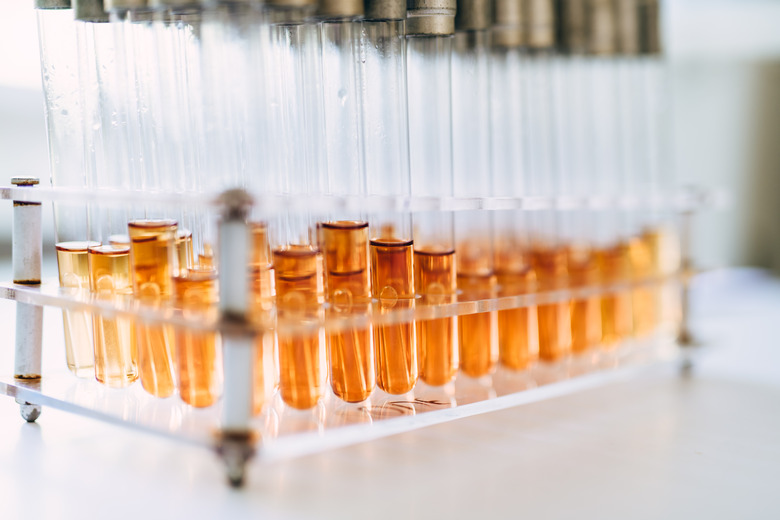Use Of A Colorimeter
A colorimeter is any instrument a chemist uses to determine or specify colors. One type of colorimeter can find the concentration of a substance in solution, based on the intensity of color of the solution. If you are testing a colorless solution, you add a reagent that reacts with the substance, producing a color. This type of colorimeter has a wide range of applications, including laboratory research, environmental analysis of water quality, analysis of soil components, monitoring of hemoglobin content in blood and analysis of chemicals used in various industrial settings.
General Principles
General Principles
When light of a particular color (or wavelength range) is directed through a chemical solution, some light is absorbed by the solution and some of it is transmitted. According to Beer's Law, the concentration of the absorbing material is proportional to a quantity known as "absorbance," defined mathematically below. Thus, if you can determine the absorbance of a solution of a substance of unknown concentration and compare it with the absorbance of solutions of known concentrations, you can find the concentration of the substance in the solution being tested.
Mathematical Equations
Mathematical Equations
The ratio of the intensity of transmitted light (I) to the intensity of incident light (Io) is called transmittance (T). In mathematical terms, T = I ÷ Io.
The absorbance (A) of the solution (at a given wavelength) is defined as equal to the logarithm (base 10) of 1÷T. That is, A = log (1÷T).
The absorbance of the solution is directly proportional to the concentration (c) of the absorbing material in solution. That is, A = kc, where "k" is a proportionality constant.
The first expression, T = I ÷ I0, indicates how much light passes through a solution, where 1 signifies maximum light transmission. The next equation, A = log (1÷T) indicates the absorption of light by taking the inverse of the transmission figure, then taking the common log of the result. So an absorbance (A) of zero means all the light passes through, 1 means 90% of the light is absorbed, and 2 means 99% is absorbed. The third expression, A = kc, tells you the concentration (c) of a solution given the absorbance number (A). For chemists, this is crucially important: the colorimeter can measure the concentration of an unknown solution by the amount of light that shines through it.
Parts of a Colorimeter
Parts of a Colorimeter
A colorimeter has three main parts: a light source, a cuvette that holds the sample solution and a photocell that detects the light transmitted through the solution. To produce colored light, the instrument may be equipped with either colored filters or specific LEDs. The light transmitted by the solution in the cuvette is detected by a photocell, producing a digital or analog signal that can be measured. Some colorimeters are portable and useful for on-site tests, while others are larger, bench-top instruments useful for laboratory testing.
Using the Instrument
Using the Instrument
With a conventional colorimeter, you will need to calibrate the instrument (using the solvent alone) and use it to determine the absorbance values of several standard solutions containing a solute at known concentrations. (If the solute produces a colorless solution, add a reagent that reacts with the solute and generates a color.) Choose the light filter or LED that gives the highest absorbance values. Plot the data to obtain a graph of absorbance versus concentration. Then use the instrument to find the absorbance of the test solution, and use the graph to find the concentration of the solute in the test solution. Modern digital colorimeters may directly show the concentration of the solute, eliminating the need for most of the above steps.
Uses of Colorimeters
Uses of Colorimeters
Besides being valuable for basic research in chemistry laboratories, colorimeters have many practical applications. For instance, they are used to test for water quality, by screening for chemicals such as:
- chlorine
- fluoride
- cyanide
- dissolved oxygen
- iron
- molybdenum
- zinc
- hydrazine
They are also used to determine the concentrations of plant nutrients (such as phosphorus, nitrate and ammonia) in the soil or hemoglobin in the blood and to identify substandard and counterfeit drugs. In addition, they are used by the food industry and by manufacturers of paints and textiles. In these disciplines, a colorimeter checks the quality and consistency of colors in paints and fabrics, to ensure that every batch comes out looking the same.
Cite This Article
MLA
Dadachanji, Dinshaw. "Use Of A Colorimeter" sciencing.com, https://www.sciencing.com/use-colorimeter-5382170/. 26 April 2018.
APA
Dadachanji, Dinshaw. (2018, April 26). Use Of A Colorimeter. sciencing.com. Retrieved from https://www.sciencing.com/use-colorimeter-5382170/
Chicago
Dadachanji, Dinshaw. Use Of A Colorimeter last modified August 30, 2022. https://www.sciencing.com/use-colorimeter-5382170/
